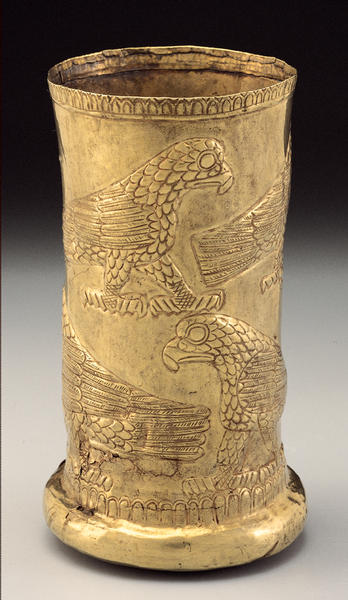Beaker with Raptors
- western Iran
- 14th - 13th century B.C.
- Electrum
- H-12.1 D-7
Catalogue Entry
The shape and proportions and even the reinforced rim of this beaker resemble those of the vessel discussed in catalogue number 21. This beaker is also made in two pieces, the cylindrical part and the bottom. The outside of the beaker is decorated with two rows of raptors, or birds of prey: Those in the upper register face toward the viewer's right, and those in the lower row, to our left. The forms are rendered in low relief, raised only slightly from the plain ground. Each bird has a hooked beak as well as a large, round eye, that is set amid a scale-like feather pattern, which covers its head, body, and upper legs; the square tail and the tapering wings are carefully rendered with long, slender feathers. Roughly crosshatched areas indicate the featherless lower legs. The species represented remains unidentified, but the short, curving beak and prominent round eye are more parrot-like than predatory. The surface of the bottom of the beaker is filled with a compass-drawn rosette, and is decorated with an overall pattern of circular punch marks.
These strutting birds find few parallels in Mesopotamian art of the later second millennium B.C., in which raptors generally are depicted in heraldically symmetrical compositions with domestic animals. Striding birds do occur, however, on a crushed-gold bowl excavated from Tomb 32 at Marlik in the southwestern region of the Caspian watershed.1 Our raptors share their stance and substantial proportions with the Marlik birds, which are more advanced technically, their heads worked in the round and turned outward toward the viewer. The Shumei beaker is rather simple and not so sophisticated and thus probably predates the Marlik bowl. Unfortunately, the fifty-three Marlik tombs, which have been dated from the fourteenth to the late eighth century B.C.,2 have as yet no secure sequence. Thus, the date of this beaker with birds is somewhat uncertain.
TSK
1. See Negahban 1983, pp. 26-27, 40-41; see Metropolitan Museum 1996, p. 31, fig. 1.
2. See Muscarella 1984, pp. 416-17.
